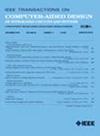通过聚类和库无关的多输出逻辑合成减少CMOS逻辑设计中的晶体管数量
IF 2.9
3区 计算机科学
Q2 COMPUTER SCIENCE, HARDWARE & ARCHITECTURE
IEEE Transactions on Computer-Aided Design of Integrated Circuits and Systems
Pub Date : 2025-02-04
DOI:10.1109/TCAD.2025.3538492
引用次数: 0
摘要
我们提出了一种新的晶体管级合成方法,以减少实现数字电路所需的晶体管数量。与传统的标准电池设计方法或基于单输入“复杂”门或“超级”门的晶体管级合成方法相比,我们的方法将多输出簇作为基本的合成单元。我们的工具采用任何门级电路网络表作为输入,并将其划分为用户控制大小的几个簇。利用MOTO-X多输出晶体管级合成工具,对集群的每个输出得到简化的乘积和(SOP)表达式,并对所有这些表达式进行联合最小化。然后,我们考虑集群组,称为“超集群”,共同减少晶体管总数。实验结果表明,与ABC合成工具相比,ISCAS ' 85、LGSynth ' 89、LGSynth ' 91、EPFL ' 15和ITC ' 99基准套件的平均晶体管数量分别减少了9.95%、6.53%、10.49%、13.09%和9.76%。此外,我们提出的方法被证明比晶体管映射二进制决策图方法更有效,突出了我们的方法在晶体管级优化集成电路的潜力,同时提供了功率效率的增强,并展示了延迟性能的各种改进。本文章由计算机程序翻译,如有差异,请以英文原文为准。
Reducing Transistor Count in CMOS Logic Design Through Clustering and Library-Independent Multiple-Output Logic Synthesis
We propose a novel transistor-level synthesis method to minimize the number of transistors needed to implement a digital circuit. In contrast with traditional standard cell design methods or transistor-level synthesis methods based on single-input “complex” gates or “super” gates, our method considers multioutput clusters as the basic resynthesis unit. Our tool takes any gate-level circuit netlist as input and divides it into several clusters of user-controlled size. For each output of a cluster, a simplified sum of product (SOP) expression is obtained and all such expressions are jointly minimized for the cluster using the MOTO-X multioutput transistor-level synthesis tool. Then, we consider groups of clusters, referred to as “superclusters,” to collectively reduce the overall transistor count. Experimental results indicate average transistor count reductions compared to the ABC synthesis tool of 9.95%, 6.53%, 10.49%, 13.09%, and 9.76% for the ISCAS’85, LGSynth’89, LGSynth’91, EPFL’15 and ITC’99 benchmark suites, respectively. Furthermore, our proposed approach proves to be more efficient than the transistor-mapped binary decision diagram approach, highlighting the potential of our methodology for optimizing integrated circuits at the transistor-level while delivering enhancements in power efficiency and demonstrating varied improvements in delay performance.
求助全文
通过发布文献求助,成功后即可免费获取论文全文。
去求助
来源期刊
CiteScore
5.60
自引率
13.80%
发文量
500
审稿时长
7 months
期刊介绍:
The purpose of this Transactions is to publish papers of interest to individuals in the area of computer-aided design of integrated circuits and systems composed of analog, digital, mixed-signal, optical, or microwave components. The aids include methods, models, algorithms, and man-machine interfaces for system-level, physical and logical design including: planning, synthesis, partitioning, modeling, simulation, layout, verification, testing, hardware-software co-design and documentation of integrated circuit and system designs of all complexities. Design tools and techniques for evaluating and designing integrated circuits and systems for metrics such as performance, power, reliability, testability, and security are a focus.

 求助内容:
求助内容: 应助结果提醒方式:
应助结果提醒方式:


